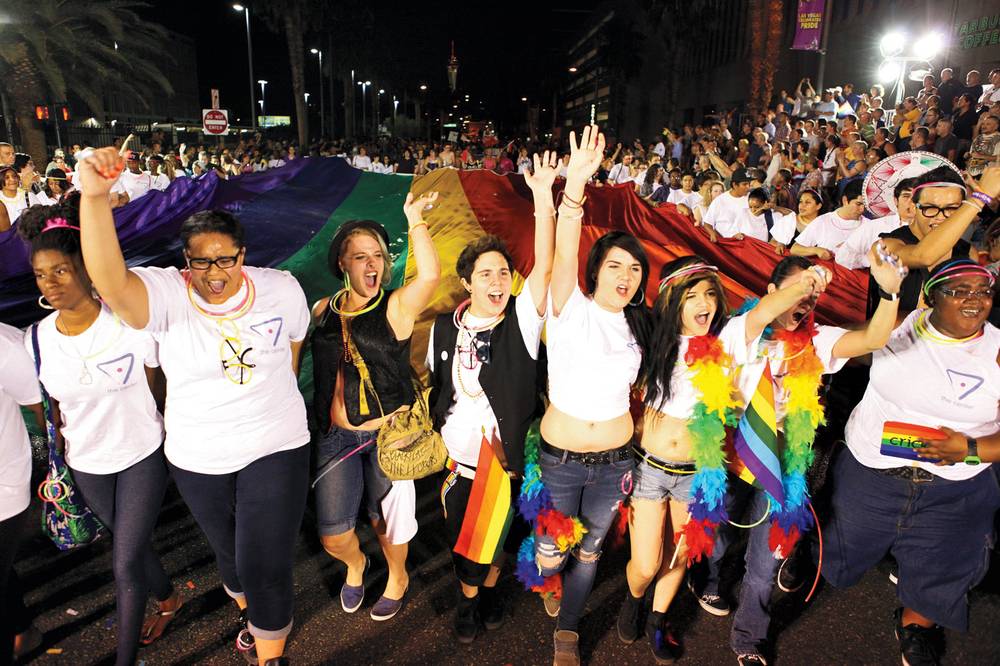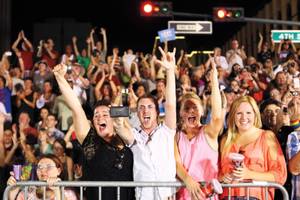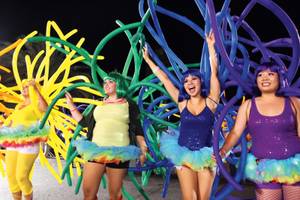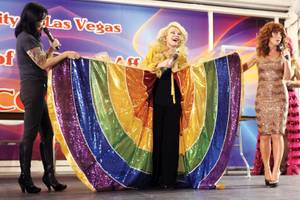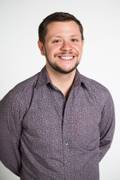More Pride
“We had to be very careful in those days, of course, using the word ‘gay’ out loud,” says local historian Dennis McBride, remembering Las Vegas’ first gay pride festival. The year was 1983, and the event’s blowout bash, the Gay Pride Dance, drew about 200 people to UNLV’s Moyer Student Union.
Nearly three decades later, last year’s Pride Night Parade drew thousands to the streets of Downtown and even more people to the accompanying festival at the Clark County Government Center—events just as colorful as the symbolic rainbow flag. The parade’s vibrantly decorated floats promenaded down Fourth Street, dance music blaring and onlookers getting down while drag queens served up fierce looks from atop their rolling chariots.
This week the party returns, as the Southern Nevada Association of Pride, Inc., celebrates the 30th anniversary of Las Vegas Pride with a Friday night parade, Saturday festival and many affiliated parties and events.
In the beginning
The first Pride celebration was a weeklong affair put on by UNLV’s Gay Academic Union, the Metropolitan Community Church and Nevadans for Human Rights. In the weeks leading up to the event, McBride remembers, two members of the GAU, president Will Collins and straight activist Christie Young, were interviewed on local television. At a time when sodomy laws were on the books, gay bars were being raided by police and members of the community could be arrested simply for being themselves, those interviews were significant.
“That in itself was quite a remarkable thing to do in Las Vegas in 1983,” says McBride, adding that Collins and Young were chosen because the organization felt the two appeared the most “straight” of its membership—the “least threatening” for a television audience.
A rally at Sunset Park was added in 1984, held in the most remote corner, where you’d end up in the desert or someone’s backyard if you ventured farther.
“They were still really closeted, and it was a very small group of people,” says McBride, recalling the wind that blew notes right out of speaker Robert Gentry’s grasp, the opening remarks given by celebrated female impersonator Kenny Kerr and the chafing dishes and tableware a local couple provided for the event’s buffet. “The first outdoor [Pride] was more like somebody’s backyard party than the gay pride celebration for Las Vegas.”
At 8 p.m. on the night of the festival, they released hundreds of balloons printed with that year’s slogan: “Unity and More in ’84.”
“So the wind and these balloons carried the Las Vegas gay pride message all over town and who knows where else, maybe all the way to the ocean,” McBride says. “That was something that we took a great deal of pride in.”
Turning inward
During the late ’80s Pride’s joyous celebrations were marred by the outbreak of the AIDS virus and ensuing epidemic within the gay community.
“The community started to turn inward, and all through that decade membership in the organizations and attendance at the events declined and declined and declined,” McBride says. After low numbers in 1985, there was no Pride celebration in 1986, save for a special service at the Metropolitan Community Church.
“We were so busy trying to get a handle on that and trying to survive and take care of each other,” says McBride, adding that the community was having to re-fight old battles, as AIDS brought back homophobia that had waned in the late ’70s and early ’80s.
Pride returned in 1987 with modest celebrations and continued over the next few years, attracting a few hundred people, until 1991, which McBride remembers as Pride’s make-or-break moment. The event succeeded, attracting more than 1,300 people.
“And from that point on, the Prides became bigger and bigger and bigger,” McBride says. “But they had to almost die before they were born again from the ashes of the AIDS epidemic.”
Growing up
It’s important to note that Las Vegas was still a young, small city in the early days of the festival, and also very late to the Pride game. Many major American cities had been celebrating Pride since the early ’70s, shortly after 1969’s Stonewall riots in New York City.
But as the Las Vegas population exploded throughout the ’90s, with many transplants arriving from cities with established gay scenes and Pride festivals, the event steadily grew. The 1993 repeal of the state’s sodomy law was a watershed moment; the community no longer had to fear being harassed or arrested for being gay.
Still, Pride stayed relatively small. Anne Davis Mulford (known by many as “Princess Anne” and a former Ms. Vegas Pride) remembers the 1992 rally at Sunset Park. “When I’ve described it in the past, I’ve said the lesbians brought their grills and the boys brought six-packs of beer.” Without a fence or admission tickets, the longtime local-turned-NYC resident says the event was like a “family picnic in the park.”
Mulford ended up serving on Pride’s volunteer board, and says that in a few short years, the organization grew the event into something “on the verge of becoming a national event.”
Volunteer Strutt Hurley brought entertainment production experience to the Vegas festival, and eventually it grew to include national names like Cyndi Lauper, who served as the grand marshal of the first Pride Parade in 1997. When the pop star opened for Tina Turner later the same night at the MGM Grand, she proudly told the audience about leading the gay pride parade.
“Everybody who was gay who was in that auditorium that night has said to me that chills went through them,” Mulford says. “It felt like an affirmation and a big step forward for all of us.”
Support & acceptance
Today, Pride reaches beyond the gay community, drawing thousands of supporters and sponsoring corporations. Some, like Wells Fargo, join in on the fun, creating floats (and colorful costumes) for the parade, while others hand out swag to festival-goers, littering Downtown streets with colorful beads à la Mardi Gras. Cox Cable even broadcasts the parade live.
SNAPI President Ernie Yuen sees the support as acceptance. “Seeing our logo on the big canopy Downtown, never in my lifetime would I have ever have thought that that would happen.”
And while Pride is meant to be a fun-filled celebration, complete with parties and Pride-friendly entertainment, it’s imperative to remember why it’s there in the first place.
“It’s important to be proud of our culture and what we bring to a community,” says Mulford, adding that many have suffered for LGBT people to walk freely down the street while holding their partners’ hands. “An event like Pride helps keep that history alive—in somebody’s mind, anyway.”
